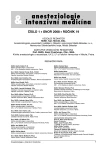Advances in the prevention, diagnostics and therapy of ventilator associated pneumonia
Authors:
P. Dostál
Authors‘ workplace:
Klinika anesteziologie, resuscitace a intenzivní medicíny Univerzita Karlova v Praze, Lékařská fakulta v Hradci Králové, Fakultní nemocnice Hradec Králové
Published in:
Anest. intenziv. Med., 19, 2008, č. 1, s. 19-22
Category:
Intensive Medicine
Overview
Results of recently published trials and meta-analyses on ventilator-associated pneumonia (VAP) suggest that the use of multi-module programmes may lead to a substantial reduction of VAP of between 31 and 57%. The use of an endotracheal tube with a polyurethane cuff and subglottic secretion drainage helps to prevent early and late-onset VAP and seems to be a promising method for VAP prevention. Invasive quantitative cultures of the broncho-alveolar lavage fluid enable higher de-escalation therapy rates that seem safe in patients with effective treatment of VAP. The combined measurement of serum procalcitonin (PCT) and BAL soluble triggering receptor expressed on myeloid cells-1 (sTREM-1) concentrations could be of interest in detecting the presence of nosocomial sepsis and in discriminating VAP versus extra-pulmonary infection. Initial adequate antibiotic therapy is a critically important determinant of the outcome of VAP. The use of combination therapy significantly reduces the likelihood of inappropriate therapy, which is associated with a higher risk of death. However, the administration of only one effective antimicrobial or combination therapy provides similar outcomes, suggesting that switching to monotherapy once the susceptibility has been established is feasible and safe. Recent data suggest that colistin can be a safe and effective option in the treatment of VAP caused by multiresistant Ps. aeruginosa or A. baumanii.
Keywords:
ventilator-associated pneumonia – mechanical ventilation – broncho-alveolar lavage – antibiotic therapy – colistin
Sources
1. Davis, K. A. Ventilator-associated pneumonia: a review. J. Intensive Care Med., 2006, 21, p. 211–226.
2. Hunter, J. D. Ventilator associated pneumonia. Postgrad. Med. J., 2006, 82, p. 172–178.
3. Niederman, M. S., Craven, S. E. et al. American Thoracic Society documents. Guidelines for the management of adults with hospital-acquired, ventilator-associated, and health care associated pneumonia. Am. J. Resp. Crit. Care Med., 2005, 171, p. 388–416.
4. Dostál, P. Pneumonie ventilovaných nemocných. In Dostál P. a kol. Základy umělé plicní ventilace. 2. vydání, Praha : Maxdorf 2005, s. 258–275.
5. Gastmeier, P., Geffers, C. Prevention of ventilator-associated pneumonia: analysis of studies published since 2004. J. Hosp. Infect., 2007, 67, p. 1–8.
6. Dodek, P., Keenan, S., Cook, D., et al. Evidence-based clinical practice guideline for the prevention of ventilator-associated pneumonia. Ann. Intern. Med., 2004, 141, p. 305–313.
7. Quenot, J. P., Ladoire, S., Devoucoux, F. et al. Effect of a nurse-implemented sedation protocol on the incidence of ventilator-associated pneumonia. Crit. Care Med., 2007, 35, p. 2031–2036.
8. Isakow, W., Morrow, L. E., Kollef, M. H. Probiotics for preventing and treating nosocomial infections: review of current evidence and recommendations. Chest, 2007, 132, p. 286–294.
9. Watkinson, P. J., Barber, V. S., Dark, P., Young, J. D. The use of pre- pro- and synbiotics in adult intensive care unit patients: systematic review. Clin. Nutr., 2007, 26, p. 182–192.
10. Valencia, M., Ferrer, M., Farre, R. et al. Automatic control of tracheal tube cuff pressure in ventilated patients in semirecumbent position: a randomized trial. Crit. Care Med., 2007, 35, p. 1543–1549.
11. Lorente, L., Lecuona, M., Jimenez, A., Mora, M. L., Sierra, A. Influence of an Endotracheal Tube with Polyurethane Cuff and Subglottic Drainage on Pneumonia. Am. J. Respir. Crit. Care Med., 2007, Oct 18, [Epub ahead of print].
12. Canadian Critical Care Trials Group A randomized trial of diagnostic techniques for ventilator-associated pneumonia. N. Engl. J. Med., 2006, 355, p. 2619–2630.
13. Fagon, J. Y., Chastre, J., Rouby, J. J. Is bronchoalveolar lavage with quantitative cultures a useful tool for diagnosing ventilator-associated pneumonia? Crit. Care, 2007, 11, p. 123.
14. Giantsou, E., Liratzopoulos, N., Efraimidou, E. et al. De- -escalation therapy rates are significantly higher by bronchoalveolar lavage than by tracheal aspirate. Intensive Care Med., 2007, 33, p. 1533–1540.
15. Gibot, S., Cravoisy, A., Dupays, R. et al. Combined measurement of procalcitonin and soluble TREM-1 in the diagnosis of nosocomial sepsis. Scand. J. Infect. Dis., 2007, 39, p. 604–608.
16. Raghavendran, K., Wang, J., Belber, C. et al. Predictive value of sputum gram stain for the determination of appropriate antibiotic therapy in ventilator-associated pneumonia. J. Trauma, 2007, 62, p. 1377–1382.
17. Teixeira, P. J., Seligman, R., Hertz, F. T., Cruz, D. B., Fachel, J. M. Inadequate treatment of ventilator-associated pneumonia: risk factors and impact on outcomes. J. Hosp. Infect., 2007, 65, p. 361–367.
18. Lisboa, T., Seligman, R., Diaz, E. et al. C-reactive protein correlates with bacterial load and appropriate antibiotic therapy in suspected ventilator-associated pneumonia. Crit. Care Med., 2007 Nov 13, [Epub ahead of print].
19. Aarts, M. A., Hancock, J. N., Heyland, D., McLeod, R. S., Marshall, J. C. Empiric antibiotic therapy for suspected ventilator-associated pneumonia: A systematic review and meta-analysis of randomized trials. Crit. Care Med., 2007 Nov 13, [Epub ahead of print].
20. Garnacho-Montero, J., Sa-Borges, M., Sole-Violan, J. et al. Optimal management therapy for Pseudomonas aeruginosa ventilator-associated pneumonia: an observational, multicenter study comparing monotherapy with combination antibiotic therapy. Crit. Care Med., 2007, 35, p. 1888–1895.
21. Kallel, H., Hergafi, L., Bahloul, M. et al. Safety and efficacy of colistin compared with imipenem in the treatment of ventilator-associated pneumonia: a matched case-control study. Intensive Care Med., 2007, 33, p. 1162–1167.
Labels
Anaesthesiology, Resuscitation and Inten Intensive Care MedicineArticle was published in
Anaesthesiology and Intensive Care Medicine

2008 Issue 1
Most read in this issue
- The management of severe acute pancreatitis – state of the art
- Polyneuropathy and myopathy of critically ill patients – what’s new?
- Current treatment of sepsis in children
- Blood purification and acute renal failure: the timing, method selection and dosing of renal replacement therapy
